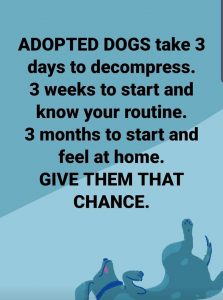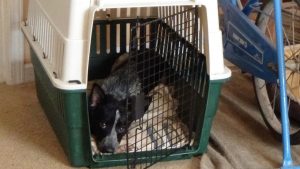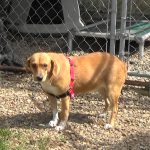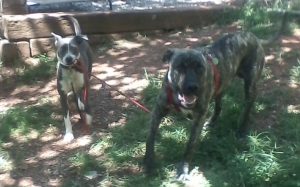As of this writing (Sept 15,2019) my wife and I have fostered 95 dogs. Some were here for only a week, some for nearly a year. Of those 95 dogs there have been 12 to 15 people who contacted me wanting to know why the dog they got from me is not behaving as advertised: getting aggressive, peeing in the house, and generally acting out. Of the cases where I was able to ask questions of them – and got honest answers – I found that this family almost always did just what they should not do with a new dog. This is to toss the new dog into the midst of the family and proceed to lavish love and permissiveness on them, thinking that this will make the dog feel welcomed and loved, so it will (of course) show it’s love for them by being well behaved and obedient. This almost never works. There are several reasons for this:
- Dogs are not short, furry people who walk on all fours. Their psychology differs from ours in several key ways.
- Entering a new home with new people and new dog siblings can be a scary proposition. Your new family member needs a little time to get his bearings.
- If arrival at your place was preceded by a many-hours-long rescue ride, she will probably be quite stressed and maybe a little nauseated.
- Once she is settled, he will need to decide where he fits into the social order of your home. It’s up to you to help him do that.
What Is Decompression?
 Decompression is a combination of acclimatization and recovery. An uncomfortable experience: a rescue run or incarceration in a shelter, will take a little time to get over. Recovery refers more to physical well being. It is a necessary step in helping your new family member (adopted or foster) settle successfully into your home.
Decompression is a combination of acclimatization and recovery. An uncomfortable experience: a rescue run or incarceration in a shelter, will take a little time to get over. Recovery refers more to physical well being. It is a necessary step in helping your new family member (adopted or foster) settle successfully into your home.
How Is Decompression Done?
I str ongly recommend using a crate in a quiet part of your home. Not in isolation – unless that turns out to be needed, just not in the center of your traffic flow.
ongly recommend using a crate in a quiet part of your home. Not in isolation – unless that turns out to be needed, just not in the center of your traffic flow.
Some people view crating a dog as cruelty. When done properly it is not. When done properly a dog will view his crate as his “room”, his personal space and a safe place to go when he’s feeling stressed. A crate should never be used as punishment.
By crating the newcomer, you can safely introduce the rest of your pack (four-legged and two legged) with reduced discomfort for the new dog and in perfect safety for you.
Make the crate as comfortable as possible with a cushion or blankets, add a couple of toys, and a bowl of water. Make sure the crate is located for easy access to an exterior door for regular walking. And check on the newbie often, preferably not en masse. Do this gently and softly. If she wants to come out and cuddle with you, fine. If not, then sit on the floor a short distance away and talk to her.
Feed him in his crate to start with. He will feel safer in there. Have ONE person do the feedings for the first week or so. This helps to establish who the top dog is, even if it’s a person. Whoever is going to be responsible for this dog needs to do these initial feedings, and needs to spend the most time with him.
Once you know all the other family pets will be tolerant of the newbie, she may come out to explore the house under supervision.
Like people, dogs have differing personalities. How much time it takes to fit into a new home will vary from dog to dog, but generally speaking, give it at least a couple of days – longer if the new dog seems nervous or frightened. The former home may have had dogs, cats, and children just like your home, but they were different dogs, cats, and children. And a different home. It’s a different lay-out, different smells and sounds. Everything here is new to this dog. Give her time to adjust and accept the changes.
The Worst Things You Can Do
Sudden Immersion Do not toss the new dog into the middle of your family without decompression time. Imagine if you were abducted from your life, everyone you know and care about, and suddenly found yourself among strangers in a strange place who act as though you should be just fine with it all. Even in a shelter, dogs form bonds with their caretakers. They know the dogs in the kennels near them. They know the smells and sounds of the place, they may not like it, but it’s what they know. Being swept away to a new life, even a life of luxury, is change and change takes time to adjust to.
Mobbed by Clowns Keep initial “getting to know you” sessions short and positive. Limit the number of visitors (human and otherwise). Mobbing the newcomer, especially if you’re all giggling and squealing with delight, will most likely be frightening.
Alone and Ignored On the other hand being lonely and ignored is counter productive.
Reward Bad Behavior If you rush in and release the dog every time she paws on the crate door or cries, you are teaching her that these bad behaviors are the means to freedom. If you think it likely that she needs to go out to potty, get her to calm down before you open the door. Reward the good behavior.
Let Him Make the Rules If you allow the new dog to set his own boundaries you are telling him that he is the boss and you are subservient. That is a horrible idea, for this will lead to aggressive behavior as he tries to fill the roll of pack leader that you set up for him. Establish your house pet rules then stick to them. Everyone in the house needs to adhere to the same rules. If Dad says “No dogs on the sofa” but Mom lets the dog sit with her while dad is gone, she’s confusing the dog and setting him up for failure. Your dog will be only as reliable as you are consistent with his training.
Award Unearned Privilege You will not bribe a dog into good behavior by offering treats or privilege. That’s one of the differences between dogs and people. Provide your dog with treats and privilege only as it is earned through the choices they make. When good choices yield a good thing (treat or privilege), good behavior is reinforced. When bad behavior results in the same rewards, bad behavior is reinforced.
SUMMARY
Give your new house guest a safe, comfortable place to stay while she adapts to her new environment. Be patient, let her progress at her speed. Reward only good behavior. Be her new pack leader. Do this and you will have a rewarding relationship with your new dog.
| Want to help save lives? |
If you enjoy our updates, Doggy Tales, and educational articles consider subscribing for notices when new pieces are posted. It’s painless and you can unsubscribe any time you want. Your e-mail address is used ONLY to deliver these notices. | [email-subscribers namefield=”YES” desc=”” group=”Public”] |







